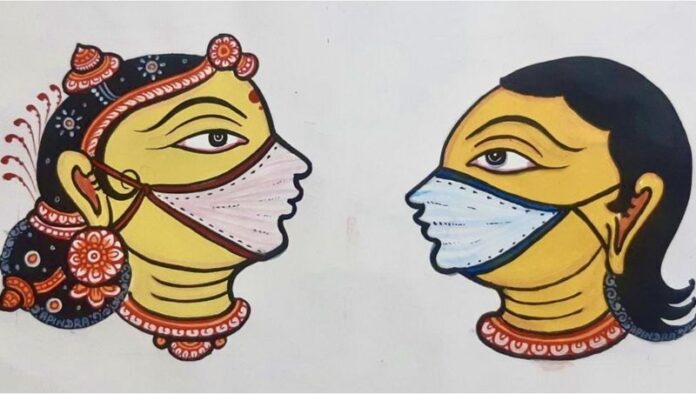India’s prominent folk artists have released a series of paintings to spread the message of social distancing and hygiene to prevent the spreading of coronavirus, writes Sudha G Tilak.
Working during the lockdown, which has now lasted more than a month, a group of folk artists and craftspeople across India have produced these illustrations and paintings in traditional styles.
“Though many fear the impact of Covid-19 may be the end of craftspeople, it is their creativity and resilience that could save them,” Laila Tyabji, chairperson of Dastkar, India’s prominent society for crafts and craftspeople, told the BBC.
Since March, folk artists who work with Dastkar have produced artwork that convey the importance of social distancing, wearing face masks, washing hands with soap and avoiding group travel. There are also scenes depicting hospitals treating Covid-19 patients.
India’s folk artists have long used traditional art for social messaging.
“Traditionally many folk art forms in India were made on large scrolls or as murals to share information with the local community. Artists would hold up scrolls in village squares and share messages or generate awareness with visuals,” says Rhea Gupta, spokesperson of Dastkar.
Ambika Devi is an artist from Rashidpur village in the northern state of Bihar. She uses a folk art form called Madhubani – which takes its name from a district in the state. The art uses natural pigments for colour and are illustrations on walls of homes and in modern times on handmade paper .
Madhubani painting has a geographical indication status because it has remained confined to a compact geographical area where the skills have been passed on through centuries and the content and style have largely remained the same.
Ambika Devi’s art shows people wearing face masks and maintaining social distancing at village markets.
Phad painting is native to Rajasthan and dates back to medieval times.
They were traditionally painted on large cloth panels showing royal scenes of festive processions and wars.
Kalyan Joshi is a Phad artist from Bhilwara in Rajasthan, an early Covid-19 hotspot. His paintings carry messages in the local language about maintaining social distancing and wearing face masks.
Apindra Swain is a Pattachitra painter from Raghurajpur in the eastern state of Orissa. This art form dates back to the 5th Century and is famous for its bright hues and faces drawn in profiles using natural colours. Her paintings show mythological figures wearing face masks.
Kavad art is a 400-year-old colourful storytelling form from the northern state of Rajasthan. Artists illustrate and paint scenes on wooden panels that look like story boards that carry messages. Dwarika Prasad, from Chittorgarh district has painted a Kavad panel to show scenes in a hospital treating Covid-19 patients.
Analysis:
I used to believe that COVID-19 brings the crisis to traditional handicrafts. However, it’s only partly true. It’s impressive to find out that Traditional art is more dynamic than I thought. It in turn helped people to get access to the information. Also, from this case, I found that the key to keeping a traditional art alive is to let it keep developing with modern content.




